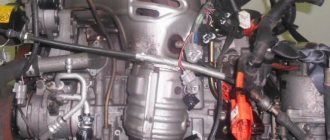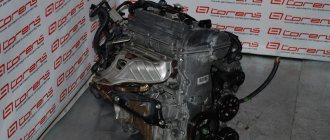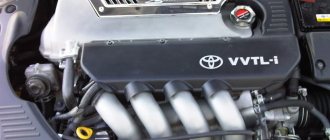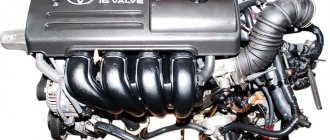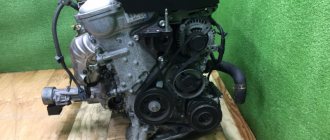Engines of the Japanese corporation Toyota AR series appeared on production cars in 2008. For some time, units of this family had a narrow purpose - for the American market. But as reliability and versatility were demonstrated, Toyota engineers began to use them widely.
The reason for the development of the motor was the need to replace the niche between the two units:
- 2.4 l – 160 l. With.;
- 3.5 l – 280 l. With.
Toyota was simultaneously replacing the outdated 2AZ-FE engine, which was used for front-wheel drive vehicles. The company's model range in this segment is quite wide - from RAV4 crossovers and large SUVs (Highlander) to the Camry passenger model. And there are also charged versions of models of a smaller class.
Modifications and technical characteristics
The successful design of the engine made it possible to produce it for various uses in two modifications:
- 2AR-FXE. Modification in a deformed version, which is used in conjunction with a hybrid power plant. The main vehicle for installation was the Camry Hybrid.
- 2AR-FSE. A modification with a longitudinal arrangement and double injection (into the cylinder and into the manifold), which works in tandem with the IS 300h unit.
In the basic version, the engine produces 181 hp. With. at a maximum of 231 Nm. The motor is mainly installed on the RAV4 crossover.
Modifications of the unit in a deformed state do not differ in the main technical parameters:
- working volume – 2493 cm2;
- cylinder diameter – piston stroke: 90.0 – 98.0, mm;
- motor weight 135 kg;
- fuel octane number – 91;
- oil filling volume 4.4 l.
The change in power is achieved by adjusting the engines according to the compression ratio, adjusting the operation of the power supply system and ignition. In terms of the materials used and the overall design, the modifications are no different. For different engine versions, the indicators are presented in the table:
Performance characteristics of 2AR-Fe motor modifications
| Characteristic | Base motor 2AR-FE | Motor modification | |
| 2AR-FXE | 2AR-FSE | ||
| Compression ratio | 10,4 | 12,5 | 13,0 |
| Power, l. With. at rpm | 181 (6000) | 160 (5700) | 178 (6000) |
| Torque, Nm at rpm. | 231 (4100) | 213 (4100) | 221 (4200) |
Toyota emphasizes that the power characteristics shown are for a naturally aspirated engine. Today, the market is dominated by small-displacement engines with one or two boost stages. In such conditions, global companies manage to obtain from 100 liters. With. and more returns from 1 liter of volume. The units of the 2AR-FE series were able to get closer to these figures.
A few words about 2AR-FE and its “brothers”
2AR-FE engines first appeared on Toyota production lines in 2008. The purpose of creating these units was the need to eliminate technically outdated 2AZ-FE, which had approximately the same properties as the subject of today’s article. Naturally, the Japanese approached the design of the “2AR” line more responsibly, using the latest innovations in the field of motor production.
The 2AR-FE/FSE/FXE engines received a number of significant differences from their ancestors. The main ones should be noted:
- Cylinder block made of aluminum with thin-bodied cast iron liners;
- Updated crankshaft and camshaft with more counterweights and improved balance;
- Lightweight pistons and fingers;
- A technically ideal cylinder head made of the same aluminum, made using twin-shaft technology;
- Innovative gas distribution mechanism - Dual-VVTi (smart direct injection);
- Volume increased to 2.5 liters.
Directly among themselves, the 2AR-FE/FSE/FXE engines are distinguished by internal adjustments that slightly adjust the compression ratio and the final functionality of the finished unit. Otherwise, all three variations of the model range are completely identical, that is, they are completely indistinguishable in terms of their design from each other.
Note that 2AR-FE engines are constantly being modernized and produced in, so to speak, special formations. For example, for some hybrid models of Toyota and Lexus, the Japanese created these installations based on the Atkinson cycle operating principle. Regardless of their type, the motors in question are still in demand and very popular, as they have decent efficiency, excellent quality and an affordable price.
What cars was it installed on?
Installed on
Toyota
| Camry XV40 | 2009 — 2011 |
| Camry XV50 | 2011 - 2017 (USA) |
| Camry XV55 | 2014 — 2018 |
| Camry XV70 | 2017 - present |
| RAV4 XA30 | 2008 — 2012 |
| RAV4 XA40 | 2012 - present |
| Alphard (Velfire) AH30 | 2015 - present |
Lexus
| ES 250 XV60 | 2015 - present |
Scion
| tC AGT20 | 2010 — 2016 |
Disadvantages and problems
As practice shows, 2.5 2AR-FE engines, with proper maintenance, can be used for a long time without repair. This family is considered one of the most reliable and durable Toyota designs. But some problems still exist.
1, 2 — VVT-I control valves at the inlet and outlet, respectively, 6 — oil pump, 7 — oil receiver, 8 — oil filter, 9 — balance shaft, 11 — oil nozzle
Motorists complain that:
- when cold, you can hear the VVT-I system clutches cracking;
- the timing chain has an insignificant resource and lasts for 150 thousand km;
- the water pump leaks, regardless of mileage;
- With a mileage of over 100 thousand km, a drop in compression is observed.
But 2AR-FE units do not have typical faults.
Oils used
The manufacturer recommends a wide range of motor oils, according to API classification:
- SL and SM "Energy-Conserving";
- SN "Resource-Conserving".
The use of universal ILSAC lubricant is allowed. Taking into account the viscosity, all recommended oils can be used in the following categories:
- 0W-20;
- 5W-20;
- 5W-30;
- 10W-30.
In the case of using universal oils, the use of viscosity compositions 15W-40 and 20W-50 is allowed.
Price of a new and contract engine
The 2AR FE modification engine is not cheap even on the secondary market. For a good contract motor they will ask for 50 thousand rubles or more. But the price is worth it. Since all engines are tested for performance at the manufacturing plants, and then they are additionally checked by our experienced mechanics.
Therefore, a car owner can’t go wrong when buying these engines. Power units are designed for a quiet ride without jerking or sudden acceleration.
Maintenance operations according to regulations
In terms of the frequency of routine maintenance, the Japanese unit of the 2AR-FE series does not differ in the composition of operations. Taking into account operating conditions, it is recommended to only change the engine oil every 7,500-10,000 km.
When replacing a technical composition with a filter, it is important to remove the waste fluid as completely as possible. When replacing, the cavity of the cylinder block must contain at least 4.2 liters. In case of untimely oil changes, clogging of the passages of the lubrication system was observed. “Oil starvation” negatively affects the resource of the unit.
During regular annual inspection (more often if possible), the antifreeze level is monitored. Taking into account the intensity of operation, but at least once every 2 years (30 thousand km), the air filter is changed.
Taking into account the use of a chain drive, periodic maintenance of the timing mechanism is not required. But every 120 thousand kilometers, a preventive replacement of the pump along with antifreeze is required.
Engine tuning
2AR-FE engines lend themselves well to tuning, which, with the right approach, can significantly increase the power of the unit. Naturally, changing “attached parts” - timing belt, cylinder head and the like - will not give anything significant. However, with a comprehensive modernization, the engine will definitely be made better.
Whether tuning 2AR is worth it or not - every car enthusiast will decide for himself. Our resource will only note that in terms of costs, modernizing Toyota engines never costs a small amount, so to implement it you will need to stock up on money. Otherwise, nothing good will be achieved.
Typical faults
Timely and high-quality engine maintenance ensures its long-term operation without major restoration repairs. However, even a serviceable engine produces noise unusual for other installations:
- Noisy timing clutches.
- Pump leaks due to untimely replacement.
- Burnout of gaskets due to overheating.
In some cases, a short resource of the chain drive was noted. An unscheduled replacement had to be made after 150 thousand km.
What do you think of this motor?
Private faults and their repair
As noted above, 2AR-FE engines are quite reliable units. Naturally, these motors do not have typical malfunctions, provided they are properly maintained. It’s impossible to say that the installations in question often bend valves or overheat. Despite this, 2AR happens:
- cooling system pump leak;
- knocking of the timing clutch (especially when cold);
- burnout of gaskets.
Of course, such breakdowns are far from serious and can be completely repaired even with your own hands.
Overhaul of 2AR-FE/FSE/FXE engines is carried out on average after 200-250,000 kilometers. It is better not to do major repairs yourself, even if you have the proper knowledge, but to entrust this operation to professionals. This approach is most preferable when using relatively complex units from Toyota.
Technical structure
At the time of its creation, the Toyota 2.5 2AR engine was considered one of the most innovative, since it used a light-alloy lined aluminum block. An open type of jacket was used for cooling.
The cast crankcase, which was used as the top of the oil pan, is attached to the cylinder block. And to reduce the load in the piston system at maximum pressure, a 10-mm desaxing (axis displacement) is provided for the crankshaft.
The crankshaft itself is equipped with:
- 8 counterweights;
- necks with reduced width;
- separate caps on the main bearings.
A drive gear transmission is provided from it to a balancing mechanism with polymer gears. Engineers equip four-cylinder Toyota engines with a volume exceeding 2 liters with this unit.
The structure of the light alloy pistons is T-shaped with a rudimentary skirt. The groove of the compression ring has an anodized layer, and its edge is coated using vapor condensation technology. The pistons are connected to the connecting rods using floating pins.
For intensive circulation of the coolant, there is a spacer in the cooling jacket. This structure helps to evenly distribute the thermal load and improve heat dissipation in the upper part of the cylinders.
The camshafts are installed separately in a special housing, mounted separately on the cylinder head to simplify maintenance. To adjust valve clearances, hydraulic compensators are used together with roller tappets or rockers. There is a line in the head cover to supply lubricant to them.
Timing chain drive, single-row. To check the hydraulic tensioner and locking mechanism, which are located on the inside of the cover, there is a service hole. The drive is lubricated separately using an oil nozzle.
One feature distinguishes the 2AR series from all its predecessors is the installation of variable valve timing drives on the camshafts and intake and exhaust valves. The range of indicators for intake is within 50 degrees and 40 for exhaust.
The cycloidal gear oil pump is driven by a chain coming from the crankshaft. The block itself has oil nozzles that “work” to lubricate the pistons.
For an oil filter mounted vertically under the engine, dismountable cassettes are provided. This structure is quite economical, since replacement cartridges are cheaper than the device.
Read also: Starline keychain instruction manual
Two-liter unit 6AR-FSE
Over the years, all generations of Camry have been equipped with time-tested 1AZ-FE engines, which were only further refined, but the overall design was the same. They were incredibly reliable: their service life reached 500 thousand kilometers. For the Camry XV50 model they were thoroughly redesigned.
The engine, having the same volume, has become 13 percent more economical and 17 percent faster. The upgraded version accelerates the car a full two seconds faster than its predecessors. Such high technology affected the resource, which became smaller. This does not mean that the engine has become unreliable, it’s just that now its service life is 350 thousand kilometers, which is very good compared to modern engines, which can operate without breakdowns for half as long.
A huge advantage of the 6AR-FSE is the timing chain drive, which can operate without problems for 200 thousand kilometers.
A few words about engines on Camry
Engine 1jz gte toyota
The power units of this model have performed well, as evidenced by reviews from experts and car owners.
The engine design is high-tech; high-pressure aluminum alloy is used to manufacture the main components.
A chain is used to drive the camshaft, and the shaft itself is equipped with a VVT-i system, which is designed to change phases. Plastic gears in the drive and polymers for the intake manifold made the engine lighter.
Two-liter engine
The seventh generation Camry, until 2014, was equipped with the XV50 engine, later it was replaced by the more improved 6AP-FSE. The working volume for them is the same and equal to 2.0 liters. The upgraded engine received distributed direct injection. The engine power was 147 hp. s., then it was possible to increase it by 3 horses. The timing chain drive, 4-speed automatic transmission was replaced by an automatic transmission with six steps.
The service life of the engines is at least 300 thousand km, and with competent, timely and high-quality maintenance, more than 450 thousand km.
Camry V40 with 2.4-liter engine
The end of the last century was marked by the appearance of the V40 2.4-liter 2AZ-FE engine; its design did not belong to highly accelerated units, but was an economical engine, which made it possible to bring the car closer to the business class.
Important! The motor has a separate chain drive for the oil pump, this ensures an instant supply of lubricant to the rubbing pairs
The fuel consumption of a Toyota Camry with such a “heart”, when traveling in the urban cycle, is in the range of 11–12 liters per hundred km. The service life is at least 300,000 km.
Engine 2.5 l
In 2012, a 2AP-FE engine with a displacement of 2.5 liters was designed and launched into production. The engine has four cylinders, which are arranged in one row. It is still considered by experts to be the most successful design in terms of dynamic performance and fuel consumption. Competent maintenance and the use of high-quality consumables allow the owner to drive 500 thousand kilometers or more without much stress. The cylinder block is cast from aluminum, in which there are cast iron liners.
The main drawback of the engine, which is indicated in the description of the machine, is that the power unit is not repairable.
Engine 3.5 l
The company's designers managed to achieve high reliability, manufacturability, and simplicity of power units that are not equipped with complex systems to reduce harmful emissions into the atmosphere. A working volume of 3.5 liters allows you to produce almost 250 horses, and after the 2GR modernization it is already more than 270 hp. With.
The cylinder block is cast from aluminum, in which cast iron liners are installed. The block design is V-shaped and has six cylinders. Engine specialists tune it and get almost 400 horses.
The timing mechanism is driven by a chain, which without any problems lasts 200 thousand km or more. The engine life is about 450 thousand km.
Toyota Camry remains one of the best-selling car brands in the world in its class. This is largely due to reliable, economical power units.
